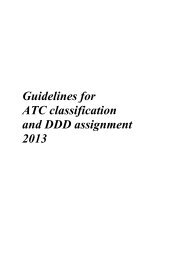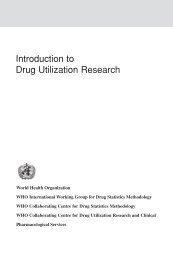Download - WHOCC
Download - WHOCC
Download - WHOCC
You also want an ePaper? Increase the reach of your titles
YUMPU automatically turns print PDFs into web optimized ePapers that Google loves.
QI<br />
IMMUNOLOGICALS<br />
In the ATCvet classification system the main group QI comprises immunologicals<br />
for veterinary use, including, vaccines, immune sera and immunoglobulins. The<br />
ATCvet group QI has been created to accomodate killed or attenuated<br />
microorganisms (bacteria, virus etc.), antigenic proteins derived from them, or<br />
synthetic constructs. Vaccines are used for the prevention, amelioration, or<br />
treatment of infectious diseases. In addition the classification in group QI enables<br />
products to be classified according to species. The main group QI has been in use<br />
since January 2000. Earlier, vaccines were classified in QJ57, and immune sera and<br />
immunoglobulins in QJ56.<br />
Immunologicals indicated for use in several species are classified according to the<br />
species regarded as the main one for prophylaxis. For example, monovalent<br />
vaccines against rabies are assigned to QI07 - Canidae. However, rabies antigens<br />
combined with other components might be classified under other main-group<br />
species.<br />
If it is not possible to decide the main species for the vaccine a ranking of main<br />
species should be performed according to the sequence of species in the ATCvet QI<br />
2 nd levels. A species with a low number in the sequence of ATCvet code should<br />
then have precedence over a species with a higher number (e.g. sheep (QI04) has<br />
precedence over horse (QI05)).<br />
Non-specific immunostimulating agents are classified in the 4th level group X -<br />
Other immunologicals, under whichever main group is considered most relevant.<br />
Other immunologicals, e.g. interferons and cytokines, are assigned to<br />
QL03 - Immunostimulants.<br />
As far as possible, products are classified consistently on the basis of the agents<br />
involved, but to make the system easy to use, sometimes both the agent and the<br />
name of the disease are given.<br />
Both for individual antigens and for combinations of antigens, any number from 1-<br />
99 may be used as a 5th level code. Unlike combinations of substances other than<br />
immunologicals, specific 5th level code series (i.e. 20, 30, 50 or 99) are not<br />
reserved for combinations of antigens in group QI.<br />
Bacterial antigens are only identified at the genus level, apart from Clostridium and<br />
Vibrio antigens.<br />
At the 4th level, all immunologicals are classified according to a specific structure.<br />
91





